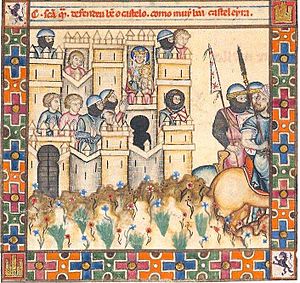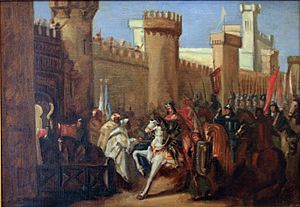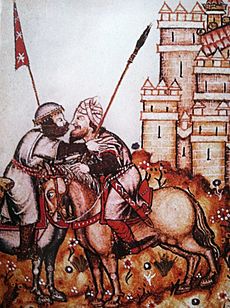Mudéjar revolt of 1264–1266 facts for kids
Quick facts for kids Mudéjar revolt of 1264–1266 |
|||||||
|---|---|---|---|---|---|---|---|
 Muhammad I of Granada (in red tunic and shield) leading his troops during the rebellion, from the Cantigas de Santa Maria. |
|||||||
|
|||||||
| Belligerents | |||||||
|
|
||||||
| Commanders and leaders | |||||||
|
|||||||
The Mudéjar revolt of 1264–1266 was a big uprising by Muslim people living in the Crown of Castile in what is now southern Spain. These Muslims were called Mudéjares. The revolt happened in the areas of Andalusia and Murcia.
The rebellion started because Castile had a policy of moving Muslim people from their homes. Muhammad I of Granada, the ruler of the independent Emirate of Granada, also helped start the revolt. The rebels got help from Granada, while the Castilians teamed up with the Kingdom of Aragon.
At the beginning of the uprising, the rebels took control of important cities like Murcia and Jerez, along with smaller towns. But eventually, the royal armies defeated them. After the defeat, Castile forced many Muslim people to leave the areas they had taken back. Christians from other places were then encouraged to move into these lands. Granada became a vassal (a state that owes loyalty and tribute) to Castile and had to pay money every year.
What Led to the Revolt?
The Reconquista and Muslim Spain
This rebellion took place during the Reconquista. This was a very long period, lasting for centuries, when Christian kingdoms in northern Spain slowly took back Muslim lands in the Iberian Peninsula. Muslims called these lands Al-Andalus.
Islam had been in Spain since the 8th century. By the early 12th century, about 5.6 million Muslims lived in the peninsula. They included Arabs, Berbers, and local people who had converted to Islam.
Over time, the Christian kingdoms grew stronger and took more land. The Muslim kingdoms became weaker. The early 13th century was a tough time for Muslims. The Almohad Caliphate, which had ruled Muslim Spain, broke apart after its leader died in 1224. Al-Andalus then split into many small kingdoms called taifas.
Castile's Growing Power
Meanwhile, Ferdinand III united the Christian kingdoms of Castile and León in 1231. He used the disunity among the Muslims to conquer many southern territories. These included the Guadalquivir basin (Lower Andalusia) and Murcia. These areas later became the main places where the Mudéjar revolt happened.
On April 2, 1243, the city of Murcia surrendered to Prince Alfonso, who would later become Alfonso X of Castile. Murcia then became a semi-independent state under Castile. Jerez, another Muslim area in Andalusia, surrendered in 1261 after a month-long siege.
Alfonso X's Policies and Muslim Life
Alfonso X became king in 1252. At this time, Muslim subjects were divided into two main groups. One group lived in Old and New Castile. They had lived under Castilian rule for centuries and had clear rights. The other group lived in areas conquered in the 13th century. These people faced political instability.
Many Muslims were forced to move by their Christian conquerors. Some moved to Muslim-ruled Granada or even to North Africa. These forced moves were seen as unfair by the Muslim population. They even protested to the Pope. These policies were a big reason why the rebellion started.
The Role of Granada
In southern Spain, the Emirate of Granada was formed under Muhammad I ibn al-Ahmar. In 1246, he agreed to pay tribute and be loyal to Castile (then ruled by Alfonso's father, Ferdinand III) for peace. Muhammad I used this peace to make his kingdom stronger. His forces even helped Castile in some campaigns against other Muslim territories, like the conquest of Seville (1248) and Jerez (1261).
However, Muhammad's loyalty to Castile was not strong. After Castile conquered the Muslim kingdom of Niebla in 1262, Muhammad I became the only independent Muslim ruler in Spain. He wanted to weaken Castile's control over its newly conquered lands.
The War Begins
First Attacks by Rebels
The revolt started at almost the same time in Lower Andalusia and Murcia. It likely began between April and June 1264. Around this time, Muhammad I's name was removed from the list of Alfonso X's loyal vassals. A small fight happened on July 10, where Granada defeated Castilian forces.
In August 1264, Muslim people in Jerez, helped by allies from Algeciras and Tarifa, attacked the Castilian army. The Castilian commander, Nuño González de Lara, left his post. The fortress was captured on August 8. According to songs from the Cantigas de Santa Maria, the Mudéjars captured all the soldiers. They also destroyed a chapel and tried to burn a statue of Mary, but the statue supposedly did not burn. Castilian reinforcements arrived two days later, but it was too late.
After Jerez, other towns in Lower Andalusia like Lebrija, Arcos, and Medina-Sidonia also fell to the rebels. However, the nearby Castle of Matrera, held by the Knights of Calatrava, was successfully defended.
In Murcia, the city of Murcia itself was captured, as well as Galera. But Orihuela was successfully defended by the royal forces. Muslims in Murcia drove out the Castilian soldiers and declared loyalty to Muhammad I. He appointed Abu Muhammad ibn Ashqilula as governor.
King James I of Aragon, Alfonso's father-in-law, wrote that "three hundred cities, great towns and castles" were captured by the rebels. He also claimed that Alfonso and Queen Violant escaped an assassination attempt in Seville. However, Alfonso did not mention any such attempt, so James's story might have been exaggerated.
Granada's Support and Limited North African Aid
The Emirate of Granada fully supported the rebellion. Later, volunteers from North Africa joined their forces. More Muslim troops from North Africa tried to land in the Guadalquivir river mouth but were pushed back by Alfonso's forces. In the end, North African troops did not play a big role in the war.
Interestingly, Muslims from Old and New Castile did not join the rebellion. These communities had been under Castilian rule for many generations. They had not been affected by Alfonso's policy of forced relocation.
Castile Fights Back
Recapturing Towns
Castilian forces began their counter-attack by marching on Jerez, a very important town. They recaptured it in late 1264 (possibly October 9). Other rebel-held towns like Vejer, Medina-Sidonia, Rota, and Sanlúcar de Barrameda also fell to the royal forces.
Muslims in the recaptured towns were forced to leave. The mosques in Jerez were turned into churches. Christians from other areas were brought in to settle these lands. Meanwhile, Queen Violant asked her father, King James I of Aragon, for help. He was not eager at first but eventually agreed.

Even though Jerez and other towns were taken back, Granadan forces continued to attack Castilian positions. The Cantigas mention an unsuccessful Granadan siege of Chincoya castle. It says the Granadan troops retreated after a statue of the Virgin Mary was placed on the castle walls. Despite this failure, Muhammad I likely captured many poorly defended castles along the border. To deal with the Granadan threat, towns in Upper Andalusia formed an alliance in Andújar on April 26, 1265, promising to work together and defend each other.
Alfonso's Invasion of Granada
Alfonso began getting ready to invade Granada. He started talking with the Banu Ashqilula, a powerful family within Granada that was against the ruling Nasrid dynasty. In early 1265, a major battle happened between Alfonso and Muhammad, and Castile won an important victory.
Alfonso then invaded Granada in late spring 1265. By summer, his forces were camped on the plains of Granada. His army raided Granada's territory, including Alcalá de Benzaide, about 40 miles from the capital city.
Aragon's Conquest of Murcia

Even though James I agreed to help Castile, he was delayed by talks with his nobles. The Catalan parliament agreed to raise taxes for the campaign in July 1264. But the Aragonese parliament first said no when they met in November. James I spent months convincing the Aragonese lords before they agreed to support his campaign.
In May 1265, religious leaders began calling for crusades. In late summer, Prince Peter raided the rebel-controlled countryside. In October, James himself led the Aragonese forces to invade rebel-held Murcia.
As James's army moved towards Murcia, Muslim-held towns in the region surrendered. These included Villena, Elda, Petrer, and Orihuela. Granada sent 2,800 men to help Murcia, but Aragonese troops defeated them. On January 2, 1266, James began a siege of the city. After some fighting and talks, Murcia surrendered on January 31. James entered the city on February 3, 1266. The city's mosque was turned into a church (later Murcia Cathedral), where James's priests held mass. With Murcia secured, James went back to his kingdom in March and did not take part in the war anymore.
The War Ends
Also in 1266, the Banu Ashqilula family rebelled against Muhammad I from their stronghold in Málaga. They offered to ally with Alfonso X. Alfonso promised to protect them and sent 1,000 men under Nuño González de Lara to defend Málaga. In return, the Banu Ashqilula might have promised to give Antequera, Archidona, and Marbella to Castile. There are not many records of battles after this point, but it seems the Castile-Banu Ashqilula alliance was gaining the upper hand.
With his allies defeated and facing enemies on two sides, Muhammad I asked for peace. He and his son (who would become Muhammad II) signed a treaty at Alcalá de Benzaide. Muhammad agreed to become Alfonso's vassal and pay a huge tribute of 250,000 maravedís (a type of currency) each year. The exact date of this treaty varies in historical records, but it was likely in late 1266 or early 1267.
What Happened After the Revolt?
Impact on Muslims in Andalusia and Murcia
The failure of the rebellion had terrible results for Muslims in Andalusia and Murcia. Castile took full control of Murcia, which had been semi-independent since 1244. Only Orihuela and Elche were taken by Aragon.
The winners punished the rebellious areas harshly. This included mass expulsion and ethnic cleansing (forcing a group of people to leave a place). Alfonso paid Christians from other places to settle the lands that were once Muslim. Mosques were turned into churches. From this point on, there were almost no Muslims left in Andalusia.
In Murcia, a large Muslim population remained. Their religious rights were guaranteed, but they were forced to move to the suburb of Arrixaca. Their homes and lands in the city were given to Christian settlers. Over time, Alfonso reduced the amount of land given to Muslims.
Impact on Granada and Castile
In Granada, the rebellion had mixed results. Granada suffered a big defeat and had to pay a huge tribute to Castile. This was much more than what it paid before the rebellion. However, signing the treaty meant Granada survived. It became the only independent Muslim state left in Spain. Muslims who were forced out by Castile moved to Granada, which made the Emirate's population stronger.
For Castile, the revolt had been a serious threat to Alfonso's rule and made him less confident. In the years after the rebellion, he achieved little. Later, his own nobles started to rebel against him, including some who had found safety in Granada. The presence of Granada on his southern border also made it harder for him to plan a crusade in Africa. The tribute payments from Granada brought in money but also caused a big problem: inflation. This reduced the real income of Castilian nobles and made it harder to attract new settlers with payments. Alfonso stayed in Jerez until late 1268, overseeing the Christian settlement and trying to control the inflation.
The Mudéjars of Old and New Castile, most of whom did not join the rebellion, were not affected by the expulsions. However, their communities became less important than before. They accepted that being quiet and having a lower status was the price for survival.
Images for kids
-
James I of Aragon entering Murcia after the rebels surrendered, February 1266.
See also
 In Spanish: Revuelta mudéjar de 1264-1266 para niños
In Spanish: Revuelta mudéjar de 1264-1266 para niños




